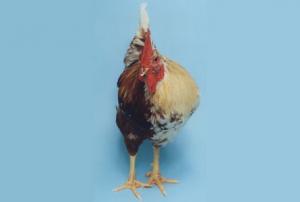2019 - Volume #43, Issue #2, Page #19
[ Sample Stories From This Issue | List of All Stories In This Issue | Print this story
| Read this issue]
Ever Heard Of A Rooster That Can Lay Eggs?
 |
In the 1920’s a Dr. Schaef from Ontario kept chickens in his backyard and one of those chickens looked like a rooster on one side and a hen on the other. Its behavior was confusing because it tried to mate with other hens but also laid eggs. Schaef decided to have it for dinner. After the bird had been plucked he noticed that each side of the bird was different. He also found a testicle on one side and an ovary on the other.
After roasting and eating the rooster/hen, the good doctor cleaned the bones and gave them to an anatomy professor who wrote about it in 1923.
The occurrence of gynandromorphism in chickens is rare, somewhere between one in 10,000 and one in 100,000, so it hasn’t been studied much. Animal science also hasn’t had the tools to observe reproduction or decipher the relationship between chromosomes and hormones until recently. One expert on the subject is Dr. Michael Clinton, from Scotland’s University of Edinburgh.
According to Dr. Clinton, gynandromorphism in chickens is caused by double fertilization and results in what looks like 2 opposite sex birds glued together. The male side has larger bones and muscles. Even the male side of the vertebrae is larger. The bird will have a male and female kidney, and other internal organs such as the heart or brain may have male and female sides.
Gynandromorphic chickens aren’t just a curiosity for Dr. Clinton. “If we can understand the differences between the male and female identities, then we can imagine making female birds with the same growth characteristics as males. That would increase productivity and food security.”
Gynandromorph research also has implications for human health. “There are differences between males and females in susceptibility to a variety of diseases and stress. Conditions like MS, dementia, addiction, and heart disease are different in men and women. Understanding gynandromorph brain development and function may help us better understand behavior traits, diseases and other disorders.”
Thankfully, the work of people like Dr. Jacob and Dr. Clinton could provide answers to many questions. The stranger-than-fiction chickens may one day lead to better health for humans.
Contact: FARM SHOW Followup, Dr. Michael Clinton, University of Edinburgh (michael.clinton@roslin.ed.ac.uk).

Click here to download page story appeared in.

Click here to read entire issue




